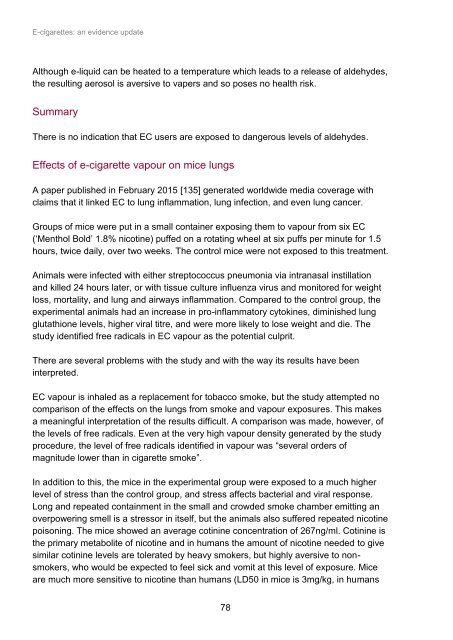E-cigarettes an evidence update A report commissioned by Public Health England
3nOaxpIe4
3nOaxpIe4
Create successful ePaper yourself
Turn your PDF publications into a flip-book with our unique Google optimized e-Paper software.
E-<strong>cigarettes</strong>: <strong>an</strong> <strong>evidence</strong> <strong>update</strong>Although e-liquid c<strong>an</strong> be heated to a temperature which leads to a release of aldehydes,the resulting aerosol is aversive to vapers <strong>an</strong>d so poses no health risk.SummaryThere is no indication that EC users are exposed to d<strong>an</strong>gerous levels of aldehydes.Effects of e-cigarette vapour on mice lungsA paper published in February 2015 [135] generated worldwide media coverage withclaims that it linked EC to lung inflammation, lung infection, <strong>an</strong>d even lung c<strong>an</strong>cer.Groups of mice were put in a small container exposing them to vapour from six EC(‘Menthol Bold’ 1.8% nicotine) puffed on a rotating wheel at six puffs per minute for 1.5hours, twice daily, over two weeks. The control mice were not exposed to this treatment.Animals were infected with either streptococcus pneumonia via intr<strong>an</strong>asal instillation<strong>an</strong>d killed 24 hours later, or with tissue culture influenza virus <strong>an</strong>d monitored for weightloss, mortality, <strong>an</strong>d lung <strong>an</strong>d airways inflammation. Compared to the control group, theexperimental <strong>an</strong>imals had <strong>an</strong> increase in pro-inflammatory cytokines, diminished lungglutathione levels, higher viral titre, <strong>an</strong>d were more likely to lose weight <strong>an</strong>d die. Thestudy identified free radicals in EC vapour as the potential culprit.There are several problems with the study <strong>an</strong>d with the way its results have beeninterpreted.EC vapour is inhaled as a replacement for tobacco smoke, but the study attempted nocomparison of the effects on the lungs from smoke <strong>an</strong>d vapour exposures. This makesa me<strong>an</strong>ingful interpretation of the results difficult. A comparison was made, however, ofthe levels of free radicals. Even at the very high vapour density generated <strong>by</strong> the studyprocedure, the level of free radicals identified in vapour was “several orders ofmagnitude lower th<strong>an</strong> in cigarette smoke”.In addition to this, the mice in the experimental group were exposed to a much higherlevel of stress th<strong>an</strong> the control group, <strong>an</strong>d stress affects bacterial <strong>an</strong>d viral response.Long <strong>an</strong>d repeated containment in the small <strong>an</strong>d crowded smoke chamber emitting <strong>an</strong>overpowering smell is a stressor in itself, but the <strong>an</strong>imals also suffered repeated nicotinepoisoning. The mice showed <strong>an</strong> average cotinine concentration of 267ng/ml. Cotinine isthe primary metabolite of nicotine <strong>an</strong>d in hum<strong>an</strong>s the amount of nicotine needed to givesimilar cotinine levels are tolerated <strong>by</strong> heavy smokers, but highly aversive to nonsmokers,who would be expected to feel sick <strong>an</strong>d vomit at this level of exposure. Miceare much more sensitive to nicotine th<strong>an</strong> hum<strong>an</strong>s (LD50 in mice is 3mg/kg, in hum<strong>an</strong>s78


